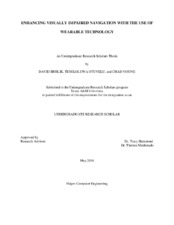| dc.description.abstract | The goal of this research was to design and develop a wearable device that enables blind users to
accomplish regular navigation, especially that of unfamiliar areas, more easily and without the
aid of a human assistant. Successful navigation includes the ability to avoid obstacles in the
user’s path as well as being able to walk to a specific destination without previous knowledge of
the directions. The main concern and need for improvement in existing technologies was the
device-user interface, which must be designed for blind individuals. The user interface was
carefully designed to maximize the amount of relevant information that could be passed to the
user but minimize the distraction and the learning curve as well as being small and discreet
enough to allow users feel comfortable wearing it in public. To meet these goals, we took the
placement of sensors on the body and vibration patterns used to communicate navigational data
to the user into consideration when designing our system. A white cane is sufficient for most
obstacle avoidance, but fails to alert the user of low hanging objects, which runs the risk of
collision with the head or shoulders. However, interviews with blind individuals showed that
because white canes or seeing-eye dogs can protect against most obstacles, navigational
guidance was preferred over obstacle avoidance in general. We discovered that the best
2
combination of wearability and functionality is a modular system whose components can be
worn according to the needs of the user. The system is designed to work in tandem with the
user’s normal obstacle avoidance method, usually a white cane or seeing-eye dog. The two
modules developed were an obstacle avoidance device that can be worn on the head or shoulders
to provide protection against low hanging objects that canes and dogs don’t provide and a
navigation belt that give directional cues to guide the wearer to a specific destination. Both
devices use haptic feedback to communicate with the user. This research will enable the blind
population to navigate both familiar and unfamiliar areas more easily and help them learn their
surroundings more effortlessly | en |


